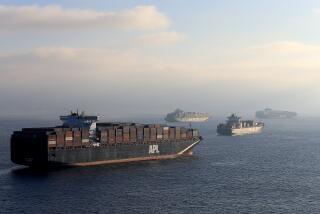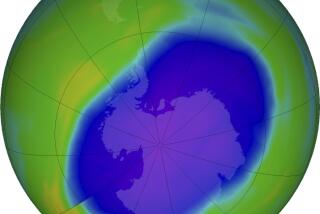Ozone-Depleting Emissions Ease, Scientists Find
Emissions of chemicals that destroy the Earth’s protective ozone level have slowed dramatically, showing that an international accord designed to protect the planet from harmful ultraviolet radiation is working, scientists reported today.
In a paper published in the journal Nature, scientists from the National Oceanic and Atmospheric Administration said worldwide emissions of the most widely used chlorofluorocarbons (CFCs) are continuing to increase but at substantially reduced rates from previous years.
The rate of increase was less than half of what had been measured before. Researchers said that shows industry has cut back its use of CFCs even more than the levels required by an international treaty signed in 1987.
Assuming the trend continues, scientists expect that the amount of chlorine in the atmosphere, which is released by CFCs and destroys the ozone layer, will peak about 2000.
“It is good news, it certainly is,” said Richard Stolarski, an ozone researcher at NASA’s Goddard Space Flight Center. “We had expected to see a decrease in the rate because of the decrease in production.”
But F. Sherwood Rowland, a professor of chemistry at UC Irvine, said the substantial slowdown was even greater than expected.
“What we now know is not only do we have an international agreement (to protect the ozone layer) but that people are going along with it,” said Rowland, who was among the first scientists to establish that the man-made chemicals are destroying the protective shield.
Even with the decline of CFCs, the outlook for the ozone layer is still not clear. It could continue to thin beyond 2000 even as chlorine levels subside, Rowland said.
The concern is due to rising levels of carbon dioxide, which is spewed into the atmosphere from the burning of coal and other fossil fuels. In the lower atmosphere, the growth in carbon dioxide is expected to warm the Earth--creating the so-called greenhouse effect. But the gas cools the stratosphere higher up, possibly accelerating chlorine’s ability to deplete the ozone layer even faster.
“So ozone depletion may in fact get worse 20, 30 and 40 years into the next century,” Rowland said. “That is a difficult calculation. . . . The only way to be sure that ozone depletion would peak would be to control carbon dioxide.”
At the 1992 Earth Summit in Brazil, nations voted to try to stabilize carbon dioxide emissions at 1990 levels by the end of the century, but that target was not mandatory.
NOAA scientists said the CFC levels began declining in 1989. Their findings were based on worldwide ground-level measurements of the chemicals, which are used as coolants, solvents and in the making of plastic foam.
Stolarski, like Rowland, cautioned that the recovery of the ozone layer will be very slow. Scientists estimate that it could take 50 to 100 years before chlorine in the stratosphere returns to pre-CFC levels.
“We are continuing to see ozone decrease, slowly decrease,” the NASA scientist said. “The turnaround, when it occurs, will be much more difficult to detect because ozone in the stratosphere fluctuates widely, from day to day, season to season, year to year.”
He noted, for example, that ozone levels have been quite low over the last year. Most scientists attribute the recent lows to the eruption of Mt. Pinatubo in the Philippines in 1991.
Scientists also say that recovery will depend on the willingness of developing nations to use CFC substitutes, which may be more expensive. China, for example, is expected to increase production of refrigeration rapidly over the next few decades.
Depletion of the ozone layer allows more harmful ultraviolet radiation to reach Earth. Higher radiation can cause increases in skin cancer and cataracts, and interfere with the growing of crops.
Rowland noted that companies, out of concern about their public image, began moving away from CFCs soon after their potential for harm became widely publicized in 1976. The international treaty known as the Montreal Protocol called for a gradual phaseout. The agreement was later amended to accelerate the ban, which is to be in full force in 1996.
“There has been a strong push by most of the companies to get out of CFCs as soon as they could,” said Rowland. “We are seeing the effects of that now.”







